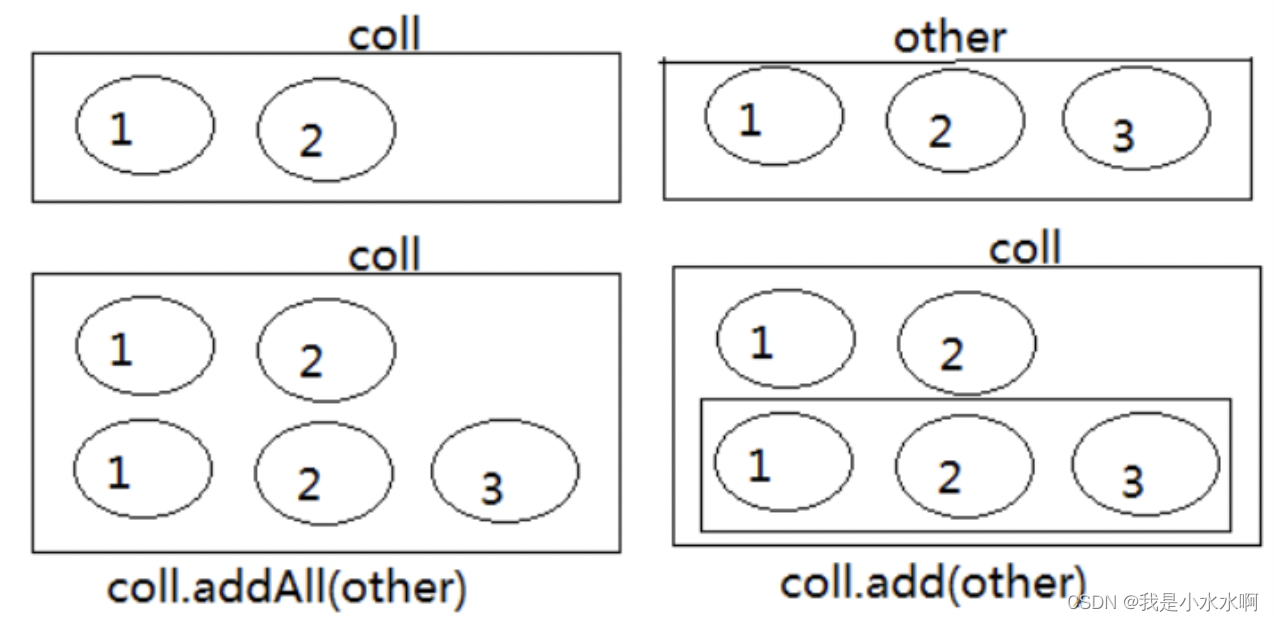java(Collection类)
文章目录
- Collection接口继承树
- Collection接口及方法
- 判断
- 删除
- 其它
- Iterator(迭代器)接口
- 迭代器的执行原理
- foreach循环
- Collection子接口1:List
- List接口特点
- List接口方法
- List接口主要实现类:ArrayList
- List的实现类之二:LinkedList
- List的实现类之三:Vector(老了)
- Collection子接口2:Set
- Set接口概述
- Set主要实现类:HashSet
- **HashSet概述**
- HashSet中添加元素的过程:
- 重写 hashCode() 方法的基本原则
- 重写equals()方法的基本原则
- 练习
- Set实现类之二:LinkedHashSet
- Set实现类之三:TreeSet
- 1 TreeSet概述
Collection接口继承树
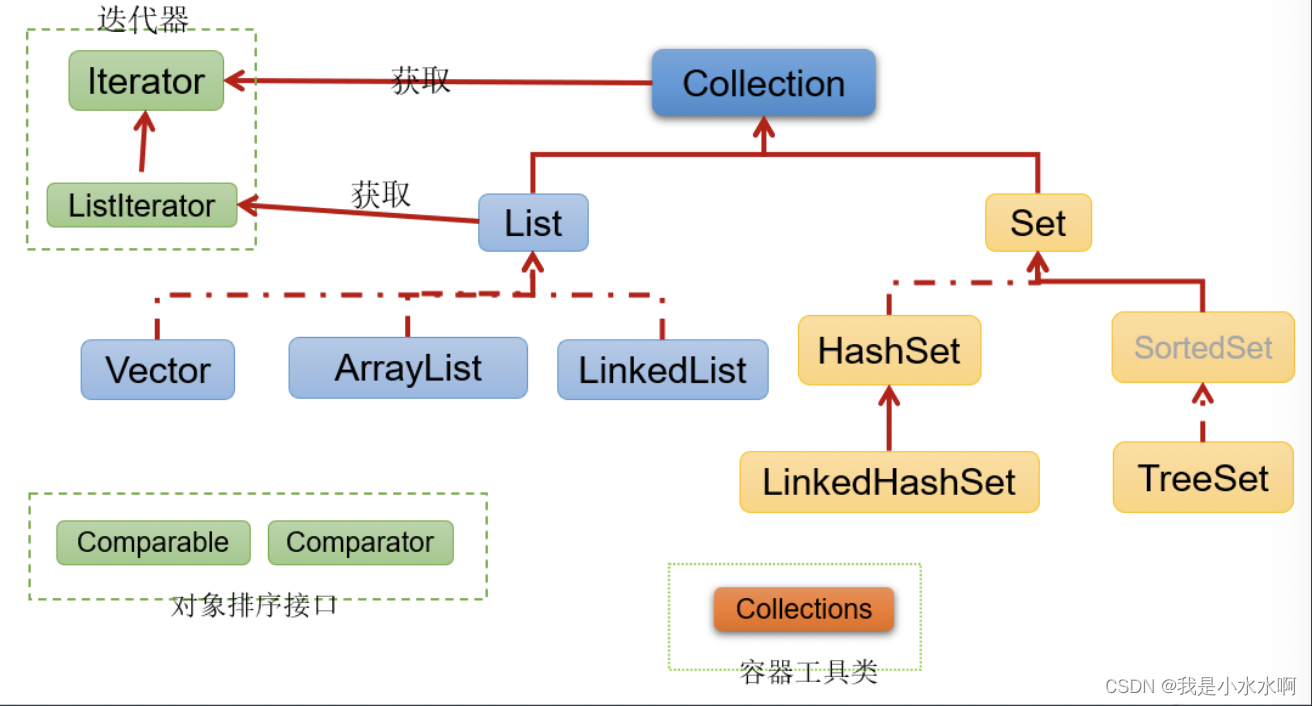
Collection接口及方法
- JDK不提供此接口的任何直接实现,而是提供更具体的子接口(如:Set和List)去实现。
- Collection 接口是 List和Set接口的父接口,该接口里定义的方法既可用于操作 Set 集合,也可用于操作 List 集合。方法如下:
- 添加:
(1)add(E obj):添加元素对象到当前集合中
(2)addAll(Collection other):添加other集合中的所有元素对象到当前集合中,即this = this ∪ other
注意:add和addAll的区别
import org.junit.Test;import java.util.ArrayList;
import java.util.Collection;public class TestCollectionAdd {@Testpublic void testAdd(){//ArrayList是Collection的子接口List的实现类之一。Collection coll = new ArrayList();// 添加coll.add("小李广");coll.add("扫地僧");coll.add("石破天");System.out.println(coll);}@Testpublic void testAddAll(){Collection c1 = new ArrayList();c1.add(1);c1.add(2);System.out.println("c1集合元素的个数:" + c1.size());//2 元素的个数System.out.println("c1 = " + c1);Collection c2 = new ArrayList();c2.add(1);c2.add(2);System.out.println("c2集合元素的个数:" + c2.size());//2System.out.println("c2 = " + c2);Collection other = new ArrayList();other.add(1);other.add(2);other.add(3);System.out.println("other集合元素的个数:" + other.size());//3System.out.println("other = " + other);System.out.println();c1.addAll(other);System.out.println("c1集合元素的个数:" + c1.size());//5System.out.println("c1.addAll(other) = " + c1);c2.add(other);System.out.println("c2集合元素的个数:" + c2.size());//3System.out.println("c2.add(other) = " + c2);}
}
判断
(3)int size():获取当前集合中实际存储的元素个数
(4)boolean isEmpty():判断当前集合是否为空集合
(5)boolean contains(Object obj):判断当前集合中是否存在一个与obj对象equals返回true的元素
(6)boolean containsAll(Collection coll):判断coll集合中的元素是否在当前集合中都存在。即coll集合是否是当前集合的“子集”
(7)boolean equals(Object obj):判断当前集合与obj是否相等
import org.junit.Test;import java.util.ArrayList;
import java.util.Collection;public class TestCollectionContains {@Testpublic void test01() {Collection coll = new ArrayList();System.out.println("coll在添加元素之前,isEmpty = " + coll.isEmpty());coll.add("小李广");coll.add("扫地僧");coll.add("石破天");coll.add("佛地魔");System.out.println("coll的元素个数" + coll.size());System.out.println("coll在添加元素之后,isEmpty = " + coll.isEmpty());}@Testpublic void test02() {Collection coll = new ArrayList();coll.add("小李广");coll.add("扫地僧");coll.add("石破天");coll.add("佛地魔");System.out.println("coll = " + coll);System.out.println("coll是否包含“小李广” = " + coll.contains("小李广"));System.out.println("coll是否包含“小爬虫” = " + coll.contains("小爬虫"));Collection other = new ArrayList()other.add("小李广");other.add("扫地僧");other.add("小爬虫");System.out.println("other = " + other);System.out.println("coll.containsAll(other) = " + coll.containsAll(other));System.out.println(coll.contains(other));}@Testpublic void test03(){Collection c1 = new ArrayList();c1.add(1);c1.add(2);System.out.println("c1集合元素的个数:" + c1.size());//2System.out.println("c1 = " + c1);Collection c2 = new ArrayList();c2.add(1);c2.add(2);System.out.println("c2集合元素的个数:" + c2.size());//2System.out.println("c2 = " + c2);Collection other = new ArrayList();other.add(1);other.add(2);other.add(3);System.out.println("other集合元素的个数:" + other.size());//3System.out.println("other = " + other);System.out.println();c1.addAll(other);System.out.println("c1集合元素的个数:" + c1.size());//5System.out.println("c1.addAll(other) = " + c1);System.out.println("c1.contains(other) = " + c1.contains(other));System.out.println("c1.containsAll(other) = " + c1.containsAll(other));System.out.println();c2.add(other);System.out.println("c2集合元素的个数:" + c2.size());System.out.println("c2.add(other) = " + c2);System.out.println("c2.contains(other) = " + c2.contains(other));System.out.println("c2.containsAll(other) = " + c2.containsAll(other));}}
删除
(8)void clear():清空集合元素
(9) boolean remove(Object obj) :从当前集合中删除第一个找到的与obj对象equals返回true的元素。
(10)boolean removeAll(Collection coll):从当前集合中删除所有与coll集合中相同的元素。即this = this - this ∩ coll
(11)boolean retainAll(Collection coll):从当前集合中删除两个集合中不同的元素,使得当前集合仅保留与coll集合中的元素相同的元素,即当前集合中仅保留两个集合的交集,即this = this ∩ coll;
注意几种删除方法的区别
import org.junit.Test;import java.util.ArrayList;
import java.util.Collection;public class TestCollectionRemove {@Testpublic void test01(){Collection coll = new ArrayList();coll.add("小李广");coll.add("扫地僧");coll.add("石破天");coll.add("佛地魔");System.out.println("coll = " + coll); //coll = [小李广, 扫地僧, 石破天, 佛地魔]coll.remove("小李广");System.out.println("删除元素\"小李广\"之后coll = " + coll); //删除元素"小李广"之后coll = [扫地僧, 石破天, 佛地魔]coll.clear();System.out.println("coll清空之后,coll = " + coll);// coll清空之后,coll = []}@Testpublic void test02() {Collection coll = new ArrayList();coll.add("小李广");coll.add("扫地僧");coll.add("石破天");coll.add("佛地魔");System.out.println("coll = " + coll); // coll = [小李广, 扫地僧, 石破天, 佛地魔]Collection other = new ArrayList();other.add("小李广");other.add("扫地僧");other.add("小爬虫");System.out.println("other = " + other); // other = [小李广, 扫地僧, 小爬虫]coll.removeAll(other);System.out.println("coll.removeAll(other)之后,coll = " + coll); //coll.removeAll(other)之后,coll = [石破天, 佛地魔]System.out.println("coll.removeAll(other)之后,other = " + other); //coll.removeAll(other)之后,other = [小李广, 扫地僧, 小爬虫]}@Testpublic void test03() {Collection coll = new ArrayList();coll.add("小李广");coll.add("扫地僧");coll.add("石破天");coll.add("佛地魔");System.out.println("coll = " + coll); // coll = [小李广, 扫地僧, 石破天, 佛地魔]Collection other = new ArrayList(); other.add("小李广");other.add("扫地僧");other.add("小伙子");System.out.println("other = " + other); // other = [小李广, 扫地僧, 小伙子]coll.retainAll(other); // 取交集System.out.println("coll.retainAll(other)之后,coll = " + coll); // coll.retainAll(other)之后,coll = [小李广, 扫地僧]System.out.println("coll.retainAll(other)之后,other = " + other); //coll.retainAll(other)之后,other = [小李广, 扫地僧, 小伙子]}}
其它
(12)Object[] toArray():返回包含当前集合中所有元素的数组
(13)hashCode():获取集合对象的哈希值
(14)iterator():返回迭代器对象,用于集合遍历
import org.junit.Test;
import java.util.ArrayList;
import java.util.Arrays;
import java.util.Collection;public class TestCollectionContains {@Testpublic void test01() {Collection coll = new ArrayList();coll.add("小李广");coll.add("扫地僧");coll.add("石破天");coll.add("佛地魔");//集合转换为数组:集合的toArray()方法Object[] objects = coll.toArray();System.out.println("用数组返回coll中所有元素:" + Arrays.toString(objects)); // 用数组返回coll中所有元素:[小李广, 扫地僧, 石破天, 佛地魔]//对应的,数组转换为集合:调用Arrays的asList(Object ...objs)Object[] arr1 = new Object[]{123,"AA","CC"};Collection list = Arrays.asList(arr1);System.out.println(list); // [123, AA, CC]}
}
Iterator(迭代器)接口
-
在程序开发中,经常需要遍历集合中的所有元素。针对这种需求,JDK专门提供了一个接口
java.util.Iterator。Iterator接口也是Java集合中的一员,但它与Collection、Map接口有所不同。- Collection接口与Map接口主要用于
存储元素 Iterator,被称为迭代器接口,本身并不提供存储对象的能力,主要用于遍历Collection中的元素
- Collection接口与Map接口主要用于
-
Collection接口继承了java.lang.Iterable接口,该接口有一个iterator()方法,那么所有实现了Collection接口的集合类都有一个iterator()方法,用以返回一个实现了Iterator接口的对象。
public Iterator iterator(): 获取集合对应的迭代器,用来遍历集合中的元素的。- 集合对象每次调用iterator()方法都得到一个全新的迭代器对象,默认游标都在集合的第一个元素之前。
-
Iterator接口的常用方法如下:
public E next():返回迭代的下一个元素。public boolean hasNext():如果仍有元素可以迭代,则返回 true。
-
注意:在调用it.next()方法之前必须要调用it.hasNext()进行检测。若不调用,且下一条记录无效,直接调用it.next()会抛出
NoSuchElementException异常。
举例:
import org.junit.Test;
import java.util.ArrayList;
import java.util.Collection;
import java.util.Iterator;public class TestIterator {@Testpublic void test01(){Collection coll = new ArrayList();coll.add("小李广");coll.add("扫地僧");coll.add("石破天");Iterator iterator = coll.iterator();System.out.println(iterator.next()); // 小李广System.out.println(iterator.next()); // 扫地僧System.out.println(iterator.next()); // 石破天System.out.println(iterator.next()); //报NoSuchElementException异常}@Testpublic void test02(){Collection coll = new ArrayList();coll.add("小李广");coll.add("扫地僧");coll.add("石破天");Iterator iterator = coll.iterator();//获取迭代器对象while(iterator.hasNext()) {//判断是否还有元素可迭代System.out.println(iterator.next());//取出下一个元素}/* 输出结果:* 小李广扫地僧石破天* */}
}
迭代器的执行原理
Iterator迭代器对象在遍历集合时,内部采用指针的方式来跟踪集合中的元素,接下来通过在这里插入代码片一个图例来演示Iterator对象迭代元素的过程:
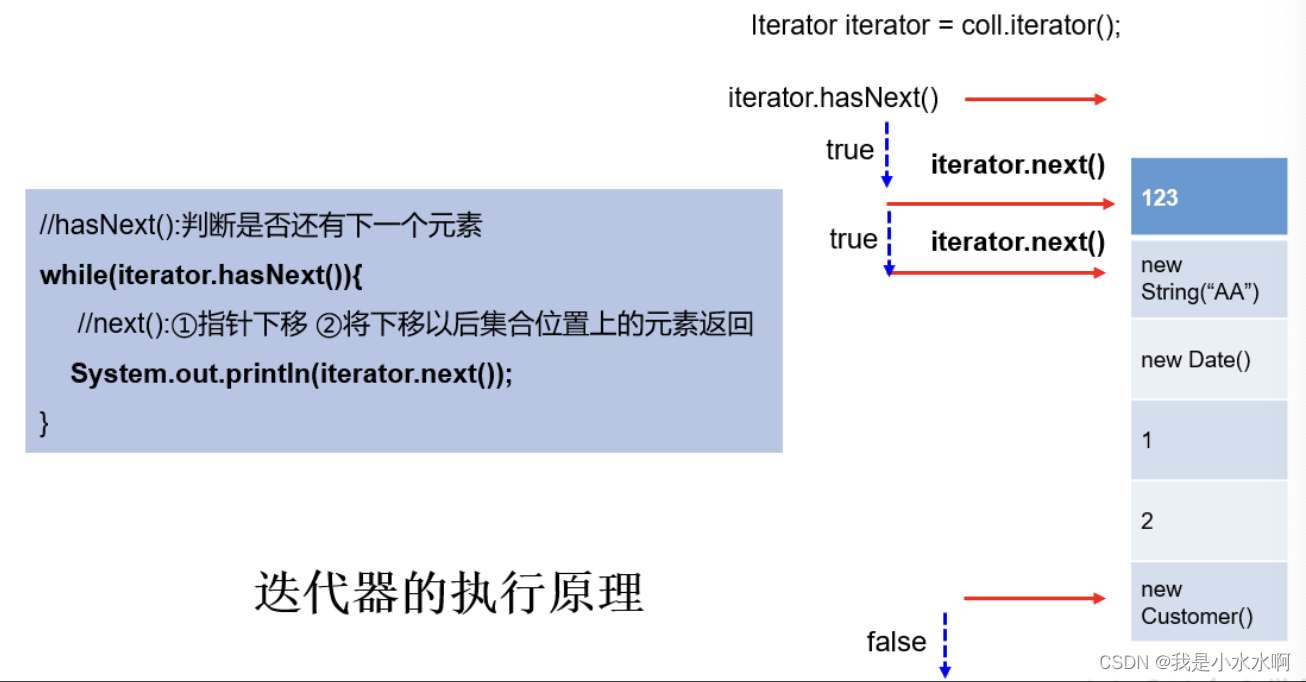
使用Iterator迭代器删除元素:java.util.Iterator迭代器中有一个方法:void remove() ;
Iterator iter = coll.iterator();//回到起点
while(iter.hasNext()){Object obj = iter.next();if(obj.equals("Tom")){iter.remove();}
}
注意:- Iterator可以删除集合的元素,但是遍历过程中通过迭代器对象的remove方法,不是集合对象的remove方法。
- 如果还未调用next()或在上一次调用 next() 方法之后已经调用了 remove() 方法,再调用remove()都会报IllegalStateException。- Collection已经有remove(xx)方法了,为什么Iterator迭代器还要提供删除方法呢?因为迭代器的remove()可以按指定的条件进行删除。
import org.junit.Test;import java.util.ArrayList;
import java.util.Collection;
import java.util.Iterator;public class TestIteratorRemove {@Testpublic void test01(){Collection coll = new ArrayList();coll.add(1);coll.add(2);coll.add(3);coll.add(4);coll.add(5);coll.add(6);Iterator iterator = coll.iterator();while(iterator.hasNext()){Integer element = (Integer) iterator.next();if(element % 2 == 0){iterator.remove();}}System.out.println(coll); // [1, 3, 5]}
}foreach循环
-
foreach循环(也称增强for循环)是 JDK5.0 中定义的一个高级for循环,专门用来
遍历数组和集合的。 -
foreach循环的语法格式:
for(元素的数据类型 局部变量 : Collection集合或数组){ //操作局部变量的输出操作
}
//这里局部变量就是一个临时变量,自己命名就可以
- 举例
import org.junit.Test;import java.util.ArrayList;
import java.util.Collection;public class TestForeach {@Testpublic void test01(){Collection coll = new ArrayList();coll.add("小李广");coll.add("扫地僧");coll.add("石破天");//foreach循环其实就是使用Iterator迭代器来完成元素的遍历的。for (Object o : coll) {System.out.println(o); // 循环遍历之前的ArrayList}}@Testpublic void test02(){int[] nums = {1,2,3,4,5};for (int num : nums) {System.out.println(num);}System.out.println("-----------------");String[] names = {"张三","李四","王五"};for (String name : names) {System.out.println(name);}}
}
对于集合的遍历,增强for的内部原理其实是个Iterator迭代器。
它用于遍历Collection和数组。通常只进行遍历元素,不要在遍历的过程中对集合元素进行增删操作。
Collection子接口1:List
List接口特点
-
鉴于Java中数组用来存储数据的局限性,我们通常使用
java.util.List替代数组 -
List集合类中
元素有序、且可重复,集合中的每个元素都有其对应的顺序索引。- 举例:List集合存储数据,就像银行门口客服,给每一个来办理业务的客户分配序号:第一个来的是“张三”,客服给他分配的是0;第二个来的是“李四”,客服给他分配的1;以此类推,最后一个序号应该是“总人数-1”。

- 举例:List集合存储数据,就像银行门口客服,给每一个来办理业务的客户分配序号:第一个来的是“张三”,客服给他分配的是0;第二个来的是“李四”,客服给他分配的1;以此类推,最后一个序号应该是“总人数-1”。
List接口方法
List除了从Collection集合继承的方法外,List 集合里添加了一些根据索引来操作集合元素的方法。
- 插入元素
void add(int index, Object ele):在index位置插入ele元素- boolean addAll(int index, Collection eles):从index位置开始将eles中的所有元素添加进来
- 获取元素
Object get(int index):获取指定index位置的元素- List subList(int fromIndex, int toIndex):返回从fromIndex到toIndex位置的子集合
- 获取元素索引
- int indexOf(Object obj):返回obj在集合中首次出现的位置
- int lastIndexOf(Object obj):返回obj在当前集合中末次出现的位置
- 删除和替换元素
-
Object remove(int index):移除指定index位置的元素,并返回此元素 -
Object set(int index, Object ele):设置指定index位置的元素为ele
举例:
-
import java.util.ArrayList;
import java.util.List;public class TestListMethod {public static void main(String[] args) {// 创建List集合对象List<String> list = new ArrayList<String>();// 往 尾部添加 指定元素list.add("图图");list.add("小美");list.add("不高兴");System.out.println(list);// add(int index,String s) 往指定位置添加list.add(1,"没头脑");System.out.println(list);// String remove(int index) 删除指定位置元素 返回被删除元素// 删除索引位置为2的元素System.out.println("删除索引位置为2的元素");System.out.println(list.remove(2));System.out.println(list);// String set(int index,String s)// 在指定位置 进行 元素替代(改)// 修改指定位置元素list.set(0, "三毛");System.out.println(list);// String get(int index) 获取指定位置元素// 跟size() 方法一起用 来 遍历的for(int i = 0;i<list.size();i++){System.out.println(list.get(i));}//还可以使用增强forfor (String string : list) {System.out.println(string);}}
}
注意:在JavaSE中List名称的类型有两个,一个是java.util.List集合接口,一个是java.awt.List图形界面的组件,别导错包了。
List接口主要实现类:ArrayList
-
ArrayList 是 List 接口的
主要实现类 -
本质上,ArrayList是对象引用的一个”变长”数组
-
Arrays.asList(…) 方法返回的 List 集合,既不是 ArrayList 实例,也不是 Vector 实例。 Arrays.asList(…) 返回值是一个固定长度的 List 集合

List的实现类之二:LinkedList
对于频繁的插入或删除元素的操作,建议使用LinkedList类,效率较高。这是由底层采用链表(双向链表)结构存储数据决定的。
特有方法:
- void addFirst(Object obj)
- void addLast(Object obj)
- Object getFirst()
- Object getLast()
- Object removeFirst()
- Object removeLast()
List的实现类之三:Vector(老了)
- Vector 是一个
古老的集合,JDK1.0就有了。大多数操作与ArrayList相同,区别之处在于Vector是线程安全的。 - 在各种List中,最好把
ArrayList作为默认选择。当插入、删除频繁时,使用LinkedList;Vector总是比ArrayList慢,所以尽量避免使用。
特有方法:
- void addElement(Object obj)
- void insertElementAt(Object obj,int index)
- void setElementAt(Object obj,int index)
- void removeElement(Object obj)
- void removeAllElements()
@Test
public void testListRemove() {List list = new ArrayList();list.add(1);list.add(2);list.add(3);updateList(list);System.out.println(list);//[1,2]
}private static void updateList(List list) {list.remove(2); // 移除下标
}
Collection子接口2:Set
Set接口概述
- Set接口是Collection的子接口,Set接口相较于Collection接口没有提供额外的方法
- Set 集合不允许包含相同的元素,如果试把两个相同的元素加入同一个 Set 集合中,则添加操作失败。
- Set集合支持的遍历方式和Collection集合一样:foreach和Iterator。
- Set的常用实现类有:HashSet、TreeSet、LinkedHashSet。
Set主要实现类:HashSet
HashSet概述
-
HashSet 是 Set 接口的主要实现类,大多数时候使用 Set 集合时都使用这个实现类。
-
HashSet 按 Hash 算法来存储集合中的元素,因此具有很好的存储、查找、删除性能。
-
HashSet 具有以下
特点:- 不能保证元素的排列顺序
- HashSet 不是线程安全的
- 集合元素可以是 null
-
HashSet 集合
判断两个元素相等的标准:两个对象通过hashCode()方法得到的哈希值相等,并且两个对象的equals()方法返回值为true。 -
对于存放在Set容器中的对象,对应的类一定要重写hashCode()和equals(Object obj)方法,以实现对象相等规则。即:“相等的对象必须具有相等的散列码”。
-
HashSet集合中元素的无序性,不等同于随机性。这里的无序性与元素的添加位置有关。具体来说:我们在添加每一个元素到数组中时,具体的存储位置是由元素的hashCode()调用后返回的hash值决定的。导致在数组中每个元素不是依次紧密存放的,表现出一定的无序性。
HashSet中添加元素的过程:
-
第1步:当向 HashSet 集合中存入一个元素时,HashSet 会调用该对象的 hashCode() 方法得到该对象的 hashCode值,然后根据 hashCode值,通过某个散列函数决定该对象在 HashSet 底层数组中的存储位置。
-
第2步:如果要在数组中存储的位置上没有元素,则直接添加成功。
-
第3步:如果要在数组中存储的位置上有元素,则继续比较:
- 如果两个元素的hashCode值不相等,则添加成功;
- 如果两个元素的hashCode()值相等,则会继续调用equals()方法:
- 如果equals()方法结果为false,则添加成功。
- 如果equals()方法结果为true,则添加失败。
第2步添加成功,元素会保存在底层数组中。
第3步两种添加成功的操作,由于该底层数组的位置已经有元素了,则会通过
链表的方式继续链接,存储。
举例:
import java.util.Objects;public class MyDate {private int year;private int month;private int day;public MyDate(int year, int month, int day) {this.year = year;this.month = month;this.day = day;}@Overridepublic boolean equals(Object o) {if (this == o) return true;if (o == null || getClass() != o.getClass()) return false;MyDate myDate = (MyDate) o;return year == myDate.year &&month == myDate.month &&day == myDate.day;}@Overridepublic int hashCode() {return Objects.hash(year, month, day);}@Overridepublic String toString() {return "MyDate{" +"year=" + year +", month=" + month +", day=" + day +'}';}
}
测试类
import org.junit.Test;import java.util.HashSet;public class TestHashSet {@Testpublic void test01(){HashSet set = new HashSet();set.add("张三");set.add("张三");set.add("李四");set.add("王五");set.add("王五");set.add("赵六");System.out.println("set = " + set);//不允许重复,无序}@Testpublic void test02(){HashSet set = new HashSet();set.add(new MyDate(2021,1,1));set.add(new MyDate(2021,1,1));set.add(new MyDate(2022,2,4));set.add(new MyDate(2022,2,4));System.out.println("set = " + set);//不允许重复,无序// set = [MyDate{year=2022, month=2, day=4}, MyDate{year=2021, month=1, day=1}]}
}
重写 hashCode() 方法的基本原则
- 在程序运行时,同一个对象多次调用 hashCode() 方法应该返回相同的值。
- 当两个对象的 equals() 方法比较返回 true 时,这两个对象的 hashCode() 方法的返回值也应相等。
- 对象中用作 equals() 方法比较的 Field,都应该用来计算 hashCode 值。
注意:如果两个元素的 equals() 方法返回 true,但它们的 hashCode() 返回值不相等,hashSet 将会把它们存储在不同的位置,但依然可以添加成功。
重写equals()方法的基本原则
-
重写equals方法的时候一般都需要同时复写hashCode方法。通常参与计算hashCode的对象的属性也应该参与到equals()中进行计算。
-
推荐:开发中直接调用Eclipse/IDEA里的快捷键自动重写equals()和hashCode()方法即可。
- 为什么用Eclipse/IDEA复写hashCode方法,有31这个数字?
首先,选择系数的时候要选择尽量大的系数。因为如果计算出来的hash地址越大,所谓的“冲突”就越少,查找起来效率也会提高。(减少冲突)其次,31只占用5bits,相乘造成数据溢出的概率较小。再次,31可以 由i*31== (i<<5)-1来表示,现在很多虚拟机里面都有做相关优化。(提高算法效率)最后,31是一个素数,素数作用就是如果我用一个数字来乘以这个素数,那么最终出来的结果只能被素数本身和被乘数还有1来整除!(减少冲突)
练习
**练习1:**在List内去除重复数字值,要求尽量简单
public static List duplicateList(List list) {HashSet set = new HashSet();set.addAll(list);return new ArrayList(set);
}
public static void main(String[] args) {List list = new ArrayList();list.add(new Integer(1));list.add(new Integer(2));list.add(new Integer(2));list.add(new Integer(4));list.add(new Integer(4));List list2 = duplicateList(list);for (Object integer : list2) {System.out.println(integer);}
}
**练习2:**获取随机数
编写一个程序,获取10个1至20的随机数,要求随机数不能重复。并把最终的随机数输出到控制台。
public class RandomValueTest {public static void main(String[] args) {HashSet hs = new HashSet(); // 创建集合对象Random r = new Random();while (hs.size() < 10) {int num = r.nextInt(20) + 1; // 生成1到20的随机数hs.add(num);}for (Integer integer : hs) { // 遍历集合System.out.println(integer); // 打印每一个元素}}
}**练习3:**去重
public class DistinctTest {public static void main(String[] args) {Scanner sc = new Scanner(System.in); // 创建键盘录入对象System.out.println("请输入一行字符串:");String line = sc.nextLine(); // 将键盘录入的字符串存储在line中char[] arr = line.toCharArray(); // 将字符串转换成字符数组HashSet hs = new HashSet(); // 创建HashSet集合对象for (Object c : arr) { // 遍历字符数组hs.add(c); // 将字符数组中的字符添加到集合中}for (Object ch : hs) { // 遍历集合System.out.print(ch);}}
}
**练习4:**面试题
import java.util.HashSet;
import java.util.Objects;public class Person {private int num;private String name;@Overridepublic String toString() {return "Person{" +"num=" + num +", name='" + name + '\'' +'}';}@Overridepublic boolean equals(Object o) {System.out.println("进入了equals方法.....");if (this == o) return true;if (o == null || getClass() != o.getClass()) return false;Person person = (Person) o;return num == person.num && Objects.equals(name, person.name);}@Overridepublic int hashCode() {return Objects.hash(num, name);}public Person(int num, String name) {this.num = num;this.name = name;}public void setNum(int num) {this.num = num;}public void setName(String name) {this.name = name;}public int getNum() {return num;}public String getName() {return name;}public static void main(String[] args) {HashSet set = new HashSet();Person p1 = new Person(1001,"AA");Person p2 = new Person(1002,"BB");set.add(p1);set.add(p2);p1.name = "CC"; System.out.println("现在集合里的元素:"+set); // 现在集合里的元素:[Person{num=1002, name='BB'}, Person{num=1001, name='CC'}] --->修改成功System.out.println("现在的p1"+p1); // 现在的 p1 也修改成功/** 在equals 方法里面 打印了 东西 但是这里也没有显示equals方法的进入,* */set.remove(p1); // 移除p1 但是移除不了 p1的hashCode() 已经改变了 进不了equal方法了 如果是进入了哈希算法相同的位置 但是之前的哈希值值 1001 AA 之后的是1001CC 所以哈希值不同。System.out.println(set); // [Person{num=1002, name='BB'}, Person{num=1001, name='CC'}]}
}类似:
import java.util.HashSet;
import java.util.Objects;public class Person {private int num;private String name;@Overridepublic String toString() {return "Person{" +"num=" + num +", name='" + name + '\'' +'}';}@Overridepublic boolean equals(Object o) {System.out.println("进入了equals方法.....");if (this == o) return true;if (o == null || getClass() != o.getClass()) return false;Person person = (Person) o;return num == person.num && Objects.equals(name, person.name);}@Overridepublic int hashCode() {return Objects.hash(num, name);}public Person(int num, String name) {this.num = num;this.name = name;}public void setNum(int num) {this.num = num;}public void setName(String name) {this.name = name;}public int getNum() {return num;}public String getName() {return name;}public static void main(String[] args) {HashSet set = new HashSet();Person p1 = new Person(1001,"AA");Person p2 = new Person(1002,"BB");set.add(p1);set.add(p2);p1.name = "CC";System.out.println("现在集合里的元素:"+set); // 现在集合里的元素:[Person{num=1002, name='BB'}, Person{num=1001, name='CC'}] --->修改成功System.out.println("现在的p1"+p1); // 现在的 p1 也修改成功/** 在equals 方法里面 打印了 东西 但是这里也没有显示equals方法的进入,* */set.remove(p1); // 移除p1 但是移除不了 p1的hashCode() 已经改变了 进不了equal方法了,就算是创建了一样的hashCode,进了equal方法也不相等了System.out.println(set); // [Person{num=1002, name='BB'}, Person{num=1001, name='CC'}]set.add(new Person(1001,"CC"));System.out.println(set); // [Person{num=1002, name='BB'}, Person{num=1001, name='CC'}, Person{num=1001, name='CC'}]
// 现在居然可以加入"相同"的对象set.add(new Person(1001,"AA"));System.out.println(set); // [Person{num=1002, name='BB'}, Person{num=1001, name='CC'}, Person{num=1001, name='CC'}, Person{num=1001, name='AA'}]//其中Person类中重写了hashCode()和equal()方法}
}Set实现类之二:LinkedHashSet
-
LinkedHashSet 是 HashSet 的子类,不允许集合元素重复。
-
LinkedHashSet 根据元素的 hashCode 值来决定元素的存储位置,但它同时使用
双向链表维护元素的次序,这使得元素看起来是以添加顺序保存的。 -
LinkedHashSet
插入性能略低于 HashSet,但在迭代访问Set 里的全部元素时有很好的性能。
朴素一点就是按顺序存储
import org.junit.Test;import java.util.LinkedHashSet;public class TestLinkedHashSet {@Testpublic void test01(){LinkedHashSet set = new LinkedHashSet();set.add("张三");set.add("张三");set.add("李四");set.add("王五");set.add("王五");set.add("赵六");System.out.println("set = " + set);//不允许重复,体现添加顺序}
}
Set实现类之三:TreeSet
1 TreeSet概述
- TreeSet 是 SortedSet 接口的实现类,TreeSet 可以按照添加的元素的指定的属性的大小顺序进行遍历。
- TreeSet底层使用
红黑树结构存储数据 - 新增的方法如下:
- Comparator comparator()
- Object first()
- Object last()
- Object lower(Object e)
- Object higher(Object e)
- SortedSet subSet(fromElement, toElement)
- SortedSet headSet(toElement)
- SortedSet tailSet(fromElement)
- TreeSet特点:不允许重复、实现排序(自然排序或定制排序)
- TreeSet 两种排序方法:
自然排序和定制排序。默认情况下,TreeSet 采用自然排序。自然排序:TreeSet 会调用集合元素的 compareTo(Object obj) 方法来比较元素之间的大小关系,然后将集合元素按升序(默认情况)排列。- 如果试图把一个对象添加到 TreeSet 时,则该对象的类必须实现 Comparable 接口。
- 实现 Comparable 的类必须实现 compareTo(Object obj) 方法,两个对象即通过 compareTo(Object obj) 方法的返回值来比较大小。
定制排序:如果元素所属的类没有实现Comparable接口,或不希望按照升序(默认情况)的方式排列元素或希望按照其它属性大小进行排序,则考虑使用定制排序。定制排序,通过Comparator接口来实现。需要重写compare(T o1,T o2)方法。- 利用int compare(T o1,T o2)方法,比较o1和o2的大小:如果方法返回正整数,则表示o1大于o2;如果返回0,表示相等;返回负整数,表示o1小于o2。
- 要实现定制排序,需要将实现Comparator接口的实例作为形参传递给TreeSet的构造器。
- 因为只有相同类的两个实例才会比较大小,所以向 TreeSet 中添加的应该是
同一个类的对象。 - 对于 TreeSet 集合而言,它判断
两个对象是否相等的唯一标准是:两个对象通过compareTo(Object obj) 或compare(Object o1,Object o2)方法比较返回值。返回值为0,则认为两个对象相等。
注意它的结构不一样,之前那种修改元素之后,在添加可能会添加出一样元素的值,这个结构不一样要特殊分析。
举例:
import org.junit.Test;
import java.util.Iterator;
import java.util.TreeSet;public class TreeSetTest {/** 自然排序:针对String类的对象* */@Testpublic void test1(){TreeSet set = new TreeSet();set.add("MM");set.add("CC");set.add("AA");set.add("DD");set.add("ZZ");//set.add(123); //报ClassCastException的异常Iterator iterator = set.iterator();while(iterator.hasNext()){System.out.println(iterator.next());}}/** 自然排序:针对User类的对象* */@Testpublic void test2(){TreeSet set = new TreeSet();set.add(new User("Tom",12));set.add(new User("Rose",23));set.add(new User("Jerry",2));set.add(new User("Eric",18));set.add(new User("Tommy",44));set.add(new User("Jim",23));set.add(new User("Maria",18));//set.add("Tom");Iterator iterator = set.iterator();while(iterator.hasNext()){System.out.println(iterator.next());}System.out.println(set.contains(new User("Jack", 23))); //true}
}
其中,User类定义如下:
public class User implements Comparable{String name;int age;public User() {}public User(String name, int age) {this.name = name;this.age = age;}@Overridepublic String toString() {return "User{" +"name='" + name + '\'' +", age=" + age +'}';}/*举例:按照age从小到大的顺序排列,如果age相同,则按照name从大到小的顺序排列* */public int compareTo(Object o) {if(this == o){return 0;}if(o instanceof User){User user = (User)o;int value = this.age - user.age;if(value != 0){return value;}return -this.name.compareTo(user.name);}throw new RuntimeException("输入的类型不匹配");}
}
/** 定制排序* */
@Test
public void test3(){//按照User的姓名的从小到大的顺序排列Comparator comparator = new Comparator() {@Overridepublic int compare(Object o1, Object o2) {if(o1 instanceof User && o2 instanceof User){User u1 = (User)o1;User u2 = (User)o2;return u1.name.compareTo(u2.name);}throw new RuntimeException("输入的类型不匹配");}};TreeSet set = new TreeSet(comparator);set.add(new User("Tom",12));set.add(new User("Rose",23));set.add(new User("Jerry",2));set.add(new User("Eric",18));set.add(new User("Tommy",44));set.add(new User("Jim",23));set.add(new User("Maria",18));//set.add(new User("Maria",28));Iterator iterator = set.iterator();while(iterator.hasNext()){System.out.println(iterator.next());}
}
**练习1:**在一个List集合中存储了多个无大小顺序并且有重复的字符串,定义一个方法,让其有序(从小到大排序),并且不能去除重复元素。
public class SortTest {public static void main(String[] args) {ArrayList list = new ArrayList();list.add("ccc");list.add("ccc");list.add("aaa");list.add("aaa");list.add("bbb");list.add("ddd");list.add("ddd");sort(list);System.out.println(list);}/** 对集合中的元素排序,并保留重复*/public static void sort(List list) {TreeSet ts = new TreeSet(new Comparator() { @Overridepublic int compare(Object o1, Object o2) { // 重写compare方法String s1 = (String)o1;String s2 = (String)o2;int num = s1.compareTo(s2); // 比较内容return num == 0 ? 1 : num; // 如果内容一样返回一个不为0的数字即可}});ts.addAll(list); // 将list集合中的所有元素添加到ts中list.clear(); // 清空listlist.addAll(ts); // 将ts中排序并保留重复的结果在添加到list中}
}**练习2:**TreeSet的自然排序和定制排序
-
定义一个Employee类。
该类包含:private成员变量name,age,birthday,其中 birthday 为 MyDate 类的对象;
并为每一个属性定义 getter, setter 方法;
并重写 toString 方法输出 name, age, birthday -
MyDate类包含:
private成员变量year,month,day;并为每一个属性定义 getter, setter 方法; -
创建该类的 5 个对象,并把这些对象放入 TreeSet 集合中(下一章:TreeSet 需使用泛型来定义)
-
分别按以下两种方式对集合中的元素进行排序,并遍历输出:
1). 使Employee 实现 Comparable 接口,并按 name 排序
2). 创建 TreeSet 时传入 Comparator对象,按生日日期的先后排序。
- 代码实现:
public class MyDate implements Comparable{private int year;private int month;private int day;public MyDate() {}public MyDate(int year, int month, int day) {this.year = year;this.month = month;this.day = day;}public int getYear() {return year;}public void setYear(int year) {this.year = year;}public int getMonth() {return month;}public void setMonth(int month) {this.month = month;}public int getDay() {return day;}public void setDay(int day) {this.day = day;}@Overridepublic String toString() {
// return "MyDate{" +
// "year=" + year +
// ", month=" + month +
// ", day=" + day +
// '}';return year + "年" + month + "月" + day + "日";}@Overridepublic int compareTo(Object o) {if(this == o){return 0;}if(o instanceof MyDate){MyDate myDate = (MyDate) o;int yearDistance = this.getYear() - myDate.getYear();if(yearDistance != 0){return yearDistance;}int monthDistance = this.getMonth() - myDate.getMonth();if(monthDistance != 0){return monthDistance;}return this.getDay() - myDate.getDay();}throw new RuntimeException("输入的类型不匹配");}
}
public class Employee implements Comparable{private String name;private int age;private MyDate birthday;public Employee() {}public Employee(String name, int age, MyDate birthday) {this.name = name;this.age = age;this.birthday = birthday;}public String getName() {return name;}public void setName(String name) {this.name = name;}public int getAge() {return age;}public void setAge(int age) {this.age = age;}public MyDate getBirthday() {return birthday;}public void setBirthday(MyDate birthday) {this.birthday = birthday;}@Overridepublic String toString() {return "Employee{" +"name='" + name + '\'' +", age='" + age + '\'' +", birthday=" + birthday +'}';}@Overridepublic int compareTo(Object o) {if(o == this){return 0;}if(o instanceof Employee){Employee emp = (Employee) o;return this.name.compareTo(emp.name);}throw new RuntimeException("传入的类型不匹配");}
}
public class EmployeeTest {/*自然排序:创建该类的 5 个对象,并把这些对象放入 TreeSet 集合中* 需求1:使Employee 实现 Comparable 接口,并按 name 排序* */@Testpublic void test1(){TreeSet set = new TreeSet();Employee e1 = new Employee("Tom",23,new MyDate(1999,7,9));Employee e2 = new Employee("Rose",43,new MyDate(1999,7,19));Employee e3 = new Employee("Jack",54,new MyDate(1998,12,21));Employee e4 = new Employee("Jerry",12,new MyDate(2002,4,21));Employee e5 = new Employee("Tony",22,new MyDate(2001,9,12));set.add(e1);set.add(e2);set.add(e3);set.add(e4);set.add(e5);//遍历Iterator iterator = set.iterator();while(iterator.hasNext()){System.out.println(iterator.next());}}/** 定制排序:* 创建 TreeSet 时传入 Comparator对象,按生日日期的先后排序。* */@Testpublic void test2(){Comparator comparator = new Comparator() {@Overridepublic int compare(Object o1, Object o2) {if(o1 instanceof Employee && o2 instanceof Employee){Employee e1 = (Employee) o1;Employee e2 = (Employee) o2;//对比两个employee的生日的大小MyDate birth1 = e1.getBirthday();MyDate birth2 = e2.getBirthday();//方式1:
// int yearDistance = birth1.getYear() - birth2.getYear();
// if(yearDistance != 0){
// return yearDistance;
// }
// int monthDistance = birth1.getMonth() - birth2.getMonth();
// if(monthDistance != 0){
// return monthDistance;
// }
//
// return birth1.getDay() - birth2.getDay();//方式2:return birth1.compareTo(birth2);}throw new RuntimeException("输入的类型不匹配");}};TreeSet set = new TreeSet(comparator);Employee e1 = new Employee("Tom",23,new MyDate(1999,7,9));Employee e2 = new Employee("Rose",43,new MyDate(1999,7,19));Employee e3 = new Employee("Jack",54,new MyDate(1998,12,21));Employee e4 = new Employee("Jerry",12,new MyDate(2002,4,21));Employee e5 = new Employee("Tony",22,new MyDate(2001,9,12));set.add(e1);set.add(e2);set.add(e3);set.add(e4);set.add(e5);//遍历Iterator iterator = set.iterator();while(iterator.hasNext()){System.out.println(iterator.next());}}
}
相关文章:
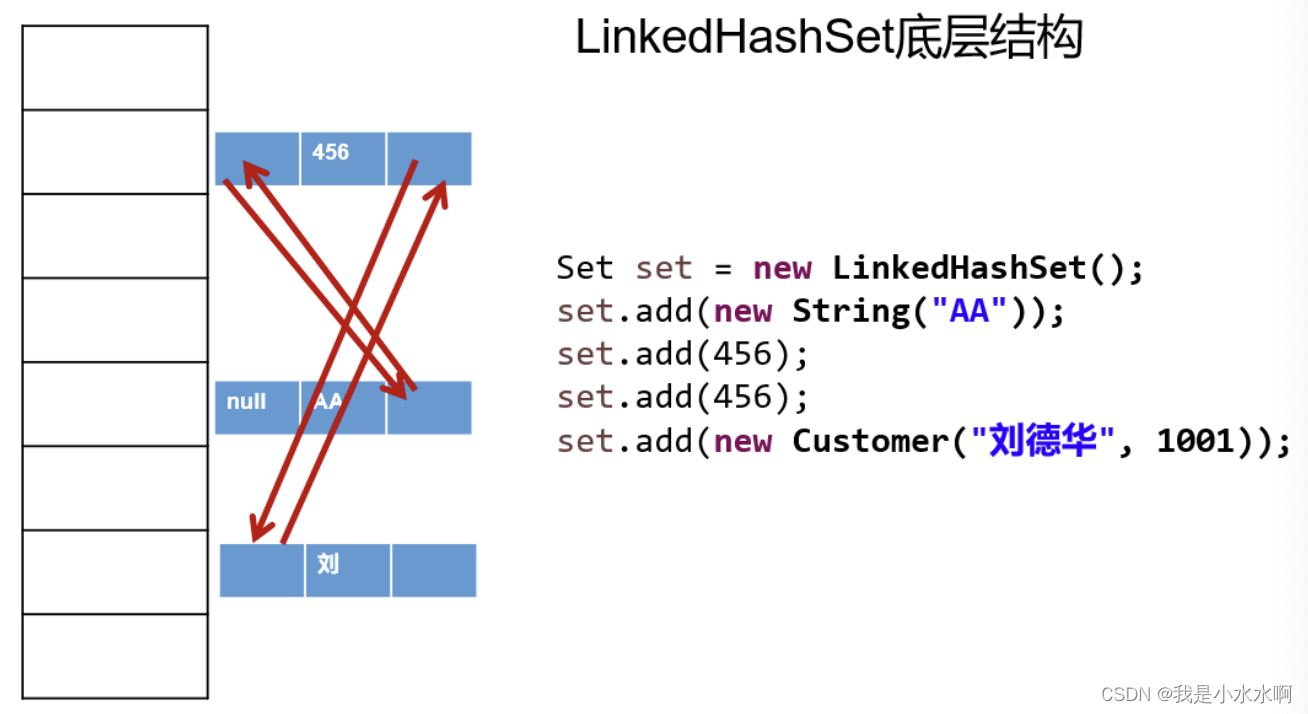
java(Collection类)
文章目录 Collection接口继承树Collection接口及方法判断删除其它 Iterator(迭代器)接口迭代器的执行原理 foreach循环Collection子接口1:ListList接口特点List接口方法List接口主要实现类:ArrayListList的实现类之二:LinkedListList的实现类…...

VS2019编译安装OpenMesh8.0
文章目录 一、简介二、相关准备三、编译安装四、举个栗子参考资料一、简介 多边形网格一直以来就是交互式3D图形应用程序中最合适的几何表示,它们足够灵活,可以近似任意形状,并且可以通过当前的图形硬件有效地处理,即使在今天的低成本电脑上也是如此。OpenMesh便是其中一种…...

Python爬虫遇到URL错误解决办法大全
在进行Python爬虫任务时,遇到URL错误是常见的问题之一。一个错误的URL链接可能导致爬虫无法访问所需的网页或资源。为了帮助您解决这个问题,本文将提供一些实用的解决方法,并给出相关代码示例,希望对您的爬虫任务有所帮助。 一、…...

基于Vue+ElementUI+Echarts+G2Plot的大屏设计器,代码完全开源
简介 🔥DataRoom是一款基于SpringBoot、MyBatisPlus、ElementUI、G2Plot、Echarts等技术栈的大屏设计器,具备大屏设计、预览、资源管理、组件管理等能力,支持JSON、MySQL、Oracle、PostgreSQL、HTTP、JavaScript、Groovy等数据集接入&#x…...

Linux - PostgreSQL 适用于9.x 以上的 tar.gz 源码安装与理解 - 报错集锦
这里写目录标题 序言主要内容bash 配置文件个人理解关于初始化 PostgreSQL 数据库的理解 启动方法检查服务器是否在PostgreSQL中运行关闭 postgresql 数据库方法参考链接 序言 PostgreSQL 9.x 以下版本笔者没用过,具体操作看参考链接,笔者就不记录重复操…...
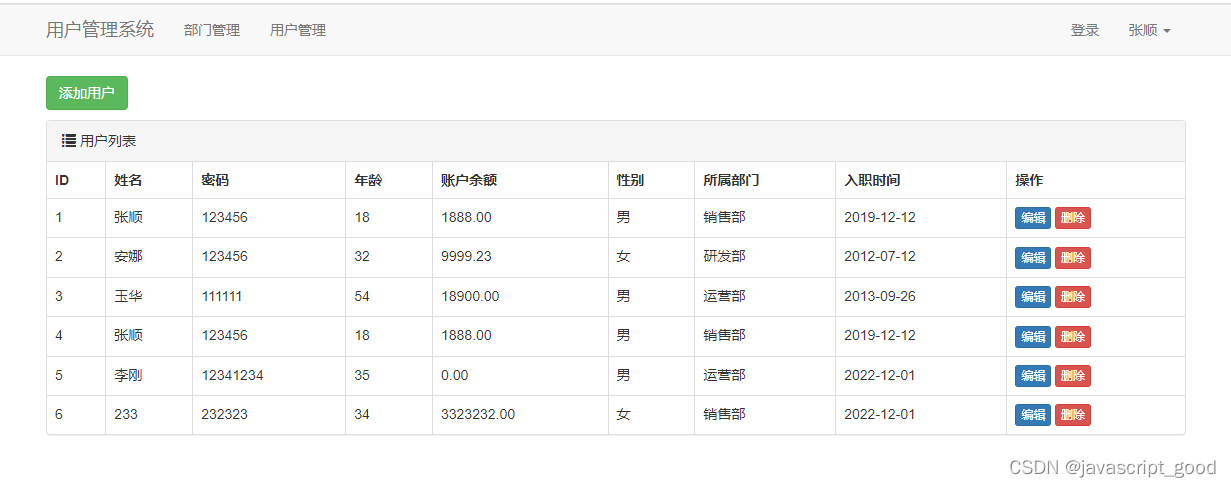
Django使用用户列表的展示和添加
接着上一篇:https://blog.csdn.net/javascript_good/article/details/132027702 来实现用户表的查询和添加 1、创建数据库表 在models.py 中,增加UserInfo类,包括字段姓名、密码、年龄、账号余额、入职时间、所属部门、性别 verbose_name 就…...

kubernetes错误汇总
title: “kubernetes错误汇总” categories: - “技术” tags: - “Kubernetes” - “错误汇总” toc: false original: true draft: false 1、增加 master etcd 报错 1.1、错误描述 由于创建的k8s集群,其中有一个master节点初始化失败,先删除了这个节…...
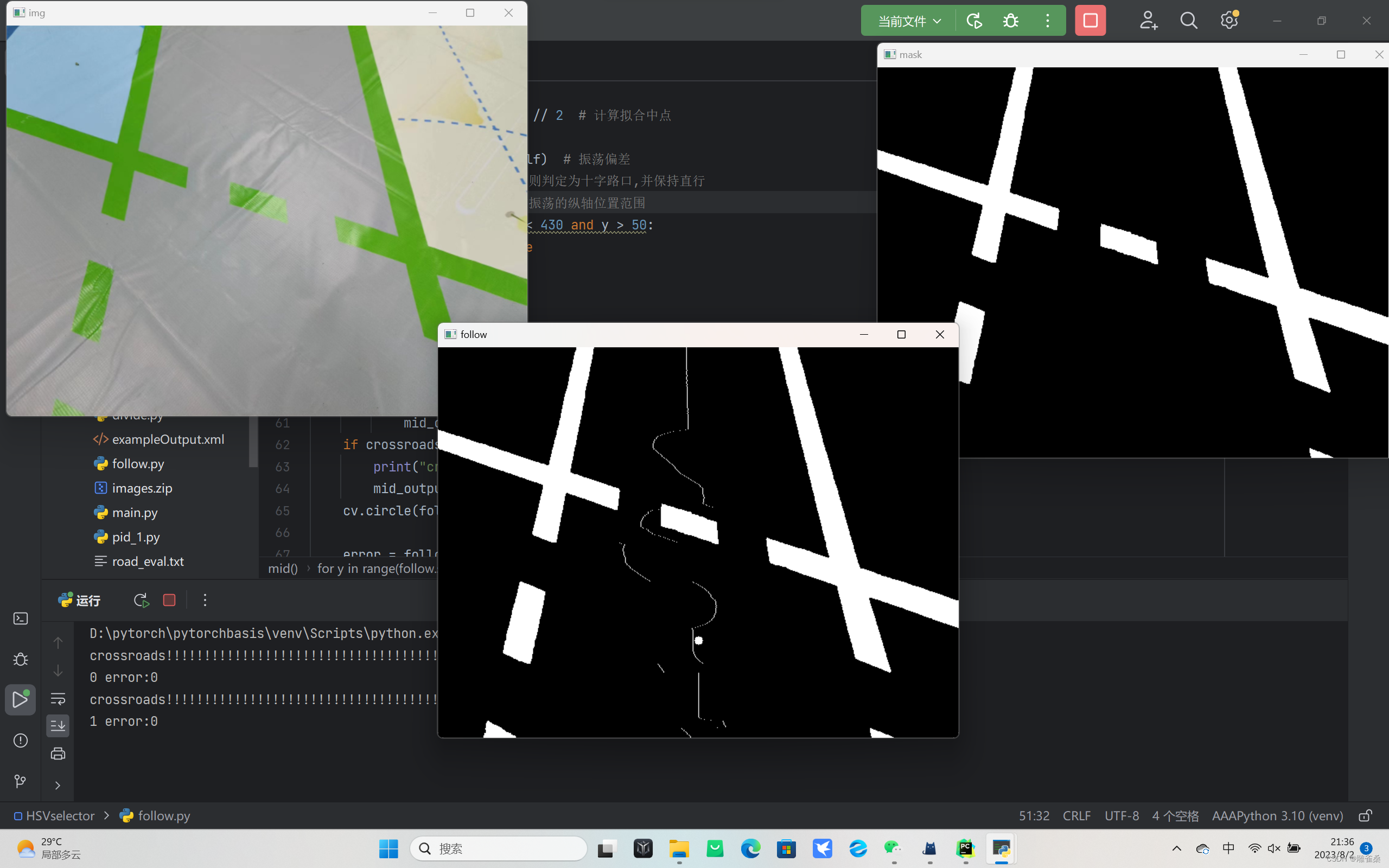
[openCV]基于拟合中线的智能车巡线方案V4
import cv2 as cv import os import numpy as np# 遍历文件夹函数 def getFileList(dir, Filelist, extNone):"""获取文件夹及其子文件夹中文件列表输入 dir:文件夹根目录输入 ext: 扩展名返回: 文件路径列表"""newDir d…...

【网络云盘客户端】——上传文件的功能的实现
目录 上传文件功能的实现 uploadtask的设计 设置上传的槽函数 uploadFileAction接口 uploadFile接口 定时上传文件 进度条的设计 上传文件功能的实现 上传文件功能实现 1.双击 ”上传文件 “的 QListWidgetItem 或者 点击 “上传” 菜单项 都会弹出一个文件对话框 2.在文…...
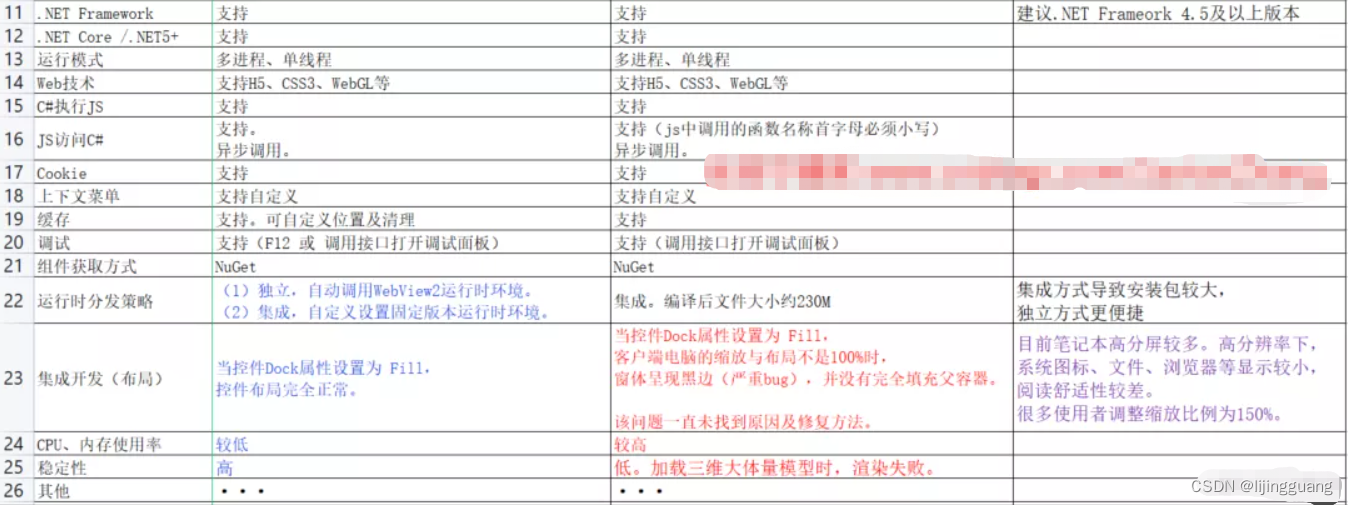
WebView2对比CefSharp的超强优势
第一次使用了CefSharp组件,集成开发结束后,测试及使用过程中遇到了一些无法处理的bug及严重的性能问题。然后又测试对比了其他多种组件,具体情况可以阅读我的博客 《.NET桌面程序集成Web网页开发的十种解决方案》。最终选用了微软新出…...

前端需要知道的计算机网络知识
1 Web 机制 无论通过有线方式 (通常是网线) 还是无线方式(比如 wifi 或蓝牙),通信需要进行连接,网络上的每台计算机需要链接到路由器(router)。 路由器确保从一台计算机上发出的一条信息可以到达正确的计算机。计算机…...
)
[2023杭电多校5 1005] Snake (生成函数)
题意 有 n n n 个标号为 1 , 2 , ⋯ , n 1,2,\cdots,n 1,2,⋯,n 的球,放到 m m m 个无标号盒子 (盒内顺序有标号),且每个盒子球数不超过 k k k,求方案数对 998 244 353 998\,244\,353 998244353 取模。 1 ≤ m , k ≤ n ≤ 1 0 6 1 \le…...

【MyBtis】各种查询功能
目录 【MyBtis】配置和映射 11.1 示例:实现表数据的增、删、改、查 1.创建工程mybatis_DML demo 2.创建数据库操作的工具类:DBOperatorMgr.java 3.创建映射接口 4.创建XML映射文件 5.测试 【MyBtis】配置和映射 MyBatis 的真正强大之外在于它的映射语句…...

H5打包封装小程序系统开发
H5打包封装小程序系统开发 H5打包封装小程序系统开发是指将H5页面打包封装成小程序的开发过程。下面是一个简单的步骤: 准备工作:首先,需要准备好H5页面的代码和资源文件。确保H5页面在浏览器中正常运行,并且没有依赖于浏览器特…...

SpringBoot集成jasypt,加密yml配置文件
SpringBoot集成jasypt,加密yml配置文件 一、pom配置二、生成密文代码三、配置3.1、yml加密配置3.2、密文配置3.3、启动配置3.4、部署配置 四、遇到的一些坑 最新项目安全检测,发现配置文件中数据库密码,redis密码仍处理明文状态 一、pom配置…...
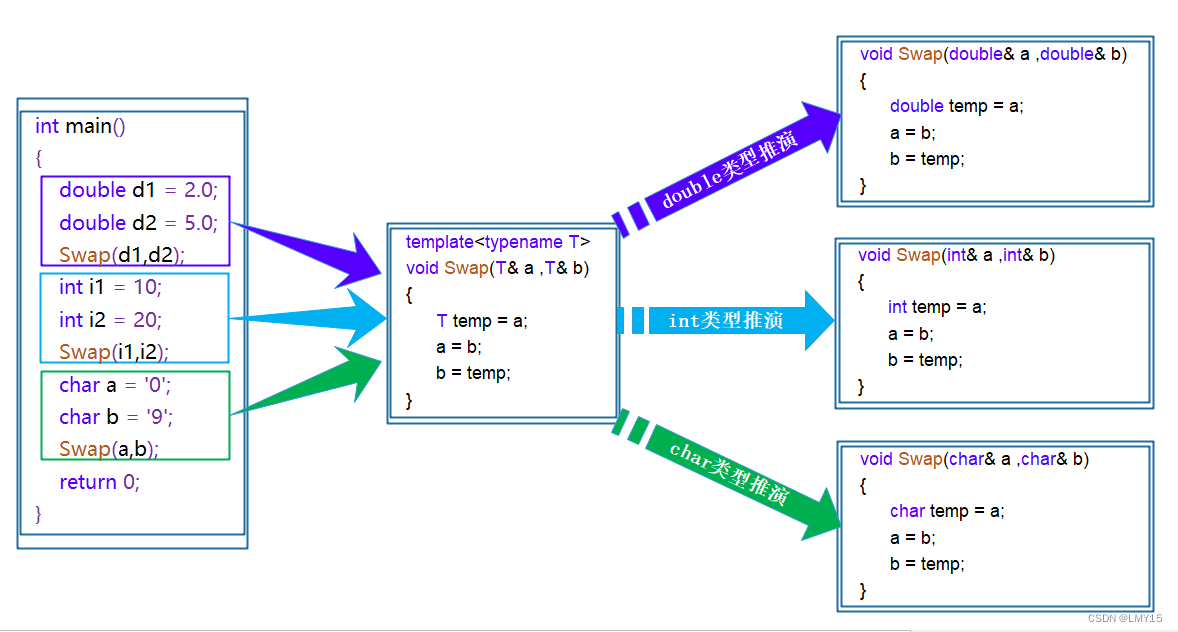
【C++】模板(初阶)
1、泛型编程 泛型编程:编写与类型无关的通用代码,是代码复用的一种手段。模板是泛型编程的基础 2、函数模板 函数模板代表了一个函数家族,该函数模板与类型无关,在使用时被参数化,根据实参类型产生函数的特定类型版本…...
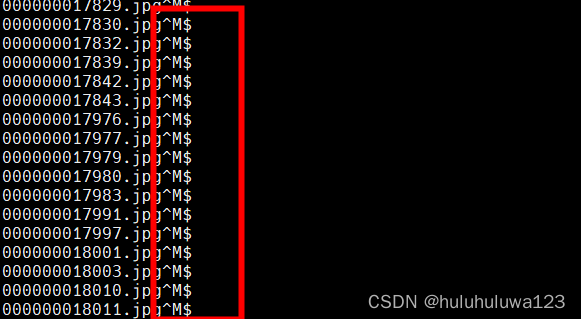
windows下的txt文档,传到ubuntu后,每行后面出现^M,怎么处理?
问题背景:windows下pycharm生成的txt文档,传到ubuntu后,每行后面出现^M 用vim打开显示 使用cat -A filename显示如下 参考https://www.lmlphp.com/user/16697/article/item/579325/给出的几种方法 方法一、dos2unix filename。服务器没装…...
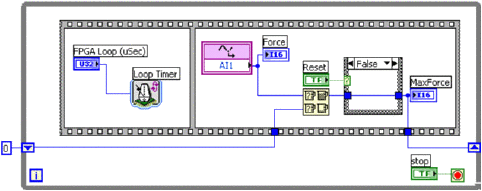
LabVIEW FPGA开发实时滑动摩擦系统
LabVIEW FPGA开发实时滑动摩擦系统 由于非线性摩擦效应的建模和补偿的固有困难,摩擦系统的运动控制已被广泛研究。最近,人们更加关注滑动动力学和滑动定位,作为传统机器人定位的低成本和更灵活的驱动替代方案。摩擦控制器设计和适当选择基础…...

Prometheus服务器、Prometheus被监控端、Grafana、Prometheus服务器、Prometheus被监控端、Grafana
day03 day03Prometheus概述部署Prometheus服务器环境说明:配置时间安装Prometheus服务器添加被监控端部署通用的监控exporterGrafana概述部署Grafana展示node1的监控信息监控MySQL数据库配置MySQL配置mysql exporter配置mysql exporter配置prometheus监控mysql自动…...
)
常见的锁策略(面试八股文)
1.乐观锁vs悲观锁 乐观锁:预测该场景中不太会出现锁冲突的情况。(后续做的工作会更少) 悲观锁:预测该场景非常容易出现锁冲突(后续做的工作会更多) 锁冲突:多个线程同时尝试去获得同一把锁&…...

挑战杯推荐项目
“人工智能”创意赛 - 智能艺术创作助手:借助大模型技术,开发能根据用户输入的主题、风格等要求,生成绘画、音乐、文学作品等多种形式艺术创作灵感或初稿的应用,帮助艺术家和创意爱好者激发创意、提高创作效率。 - 个性化梦境…...
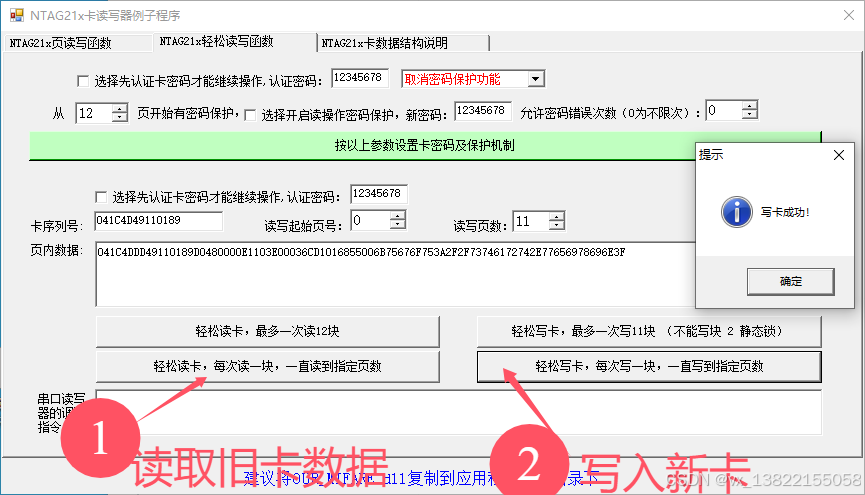
VB.net复制Ntag213卡写入UID
本示例使用的发卡器:https://item.taobao.com/item.htm?ftt&id615391857885 一、读取旧Ntag卡的UID和数据 Private Sub Button15_Click(sender As Object, e As EventArgs) Handles Button15.Click轻松读卡技术支持:网站:Dim i, j As IntegerDim cardidhex, …...
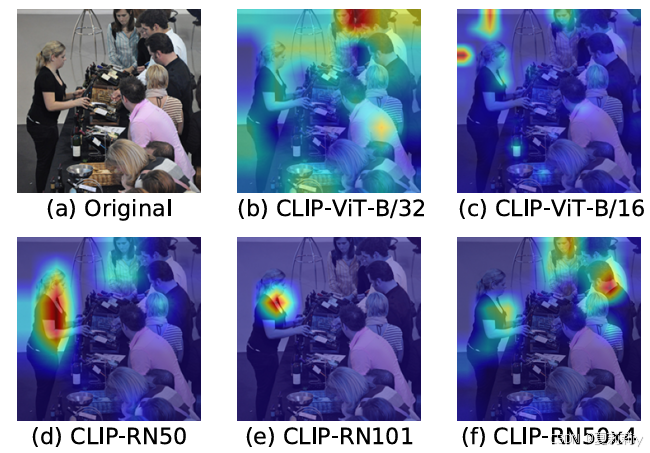
[ICLR 2022]How Much Can CLIP Benefit Vision-and-Language Tasks?
论文网址:pdf 英文是纯手打的!论文原文的summarizing and paraphrasing。可能会出现难以避免的拼写错误和语法错误,若有发现欢迎评论指正!文章偏向于笔记,谨慎食用 目录 1. 心得 2. 论文逐段精读 2.1. Abstract 2…...

如何将联系人从 iPhone 转移到 Android
从 iPhone 换到 Android 手机时,你可能需要保留重要的数据,例如通讯录。好在,将通讯录从 iPhone 转移到 Android 手机非常简单,你可以从本文中学习 6 种可靠的方法,确保随时保持连接,不错过任何信息。 第 1…...

c#开发AI模型对话
AI模型 前面已经介绍了一般AI模型本地部署,直接调用现成的模型数据。这里主要讲述讲接口集成到我们自己的程序中使用方式。 微软提供了ML.NET来开发和使用AI模型,但是目前国内可能使用不多,至少实践例子很少看见。开发训练模型就不介绍了&am…...

初学 pytest 记录
安装 pip install pytest用例可以是函数也可以是类中的方法 def test_func():print()class TestAdd: # def __init__(self): 在 pytest 中不可以使用__init__方法 # self.cc 12345 pytest.mark.api def test_str(self):res add(1, 2)assert res 12def test_int(self):r…...

Fabric V2.5 通用溯源系统——增加图片上传与下载功能
fabric-trace项目在发布一年后,部署量已突破1000次,为支持更多场景,现新增支持图片信息上链,本文对图片上传、下载功能代码进行梳理,包含智能合约、后端、前端部分。 一、智能合约修改 为了增加图片信息上链溯源,需要对底层数据结构进行修改,在此对智能合约中的农产品数…...
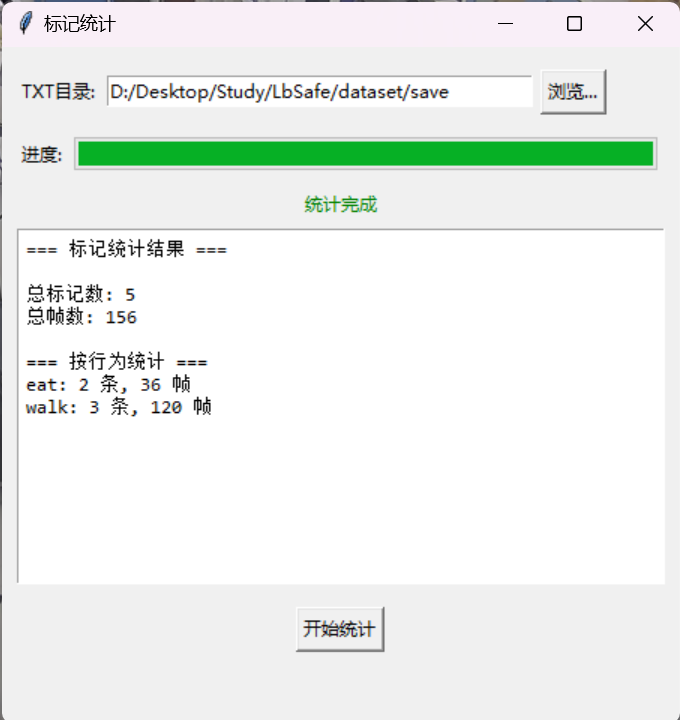
视频行为标注工具BehaviLabel(源码+使用介绍+Windows.Exe版本)
前言: 最近在做行为检测相关的模型,用的是时空图卷积网络(STGCN),但原有kinetic-400数据集数据质量较低,需要进行细粒度的标注,同时粗略搜了下已有开源工具基本都集中于图像分割这块,…...

【Android】Android 开发 ADB 常用指令
查看当前连接的设备 adb devices 连接设备 adb connect 设备IP 断开已连接的设备 adb disconnect 设备IP 安装应用 adb install 安装包的路径 卸载应用 adb uninstall 应用包名 查看已安装的应用包名 adb shell pm list packages 查看已安装的第三方应用包名 adb shell pm list…...
 Module Federation:Webpack.config.js文件中每个属性的含义解释)
MFE(微前端) Module Federation:Webpack.config.js文件中每个属性的含义解释
以Module Federation 插件详为例,Webpack.config.js它可能的配置和含义如下: 前言 Module Federation 的Webpack.config.js核心配置包括: name filename(定义应用标识) remotes(引用远程模块࿰…...

